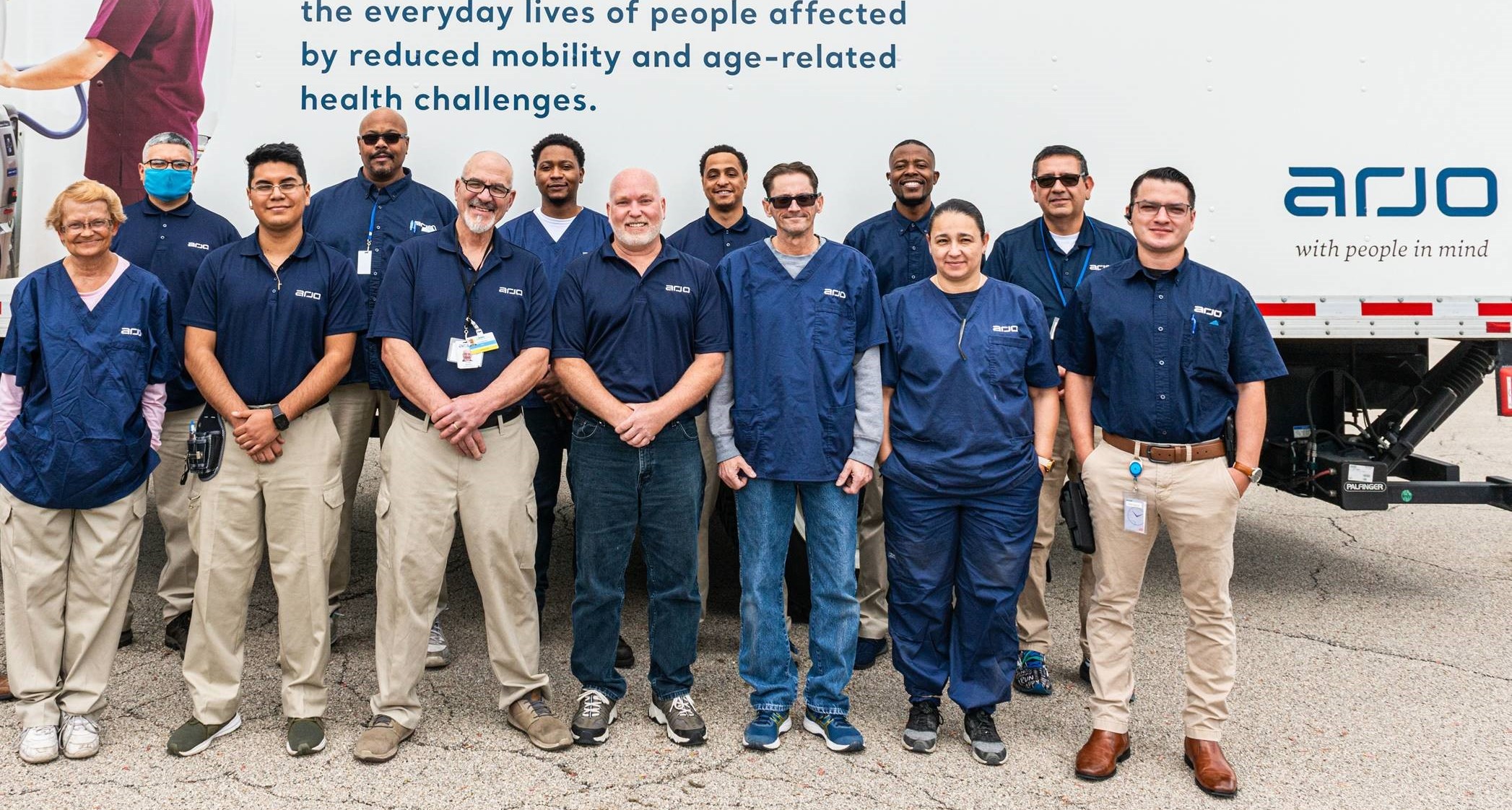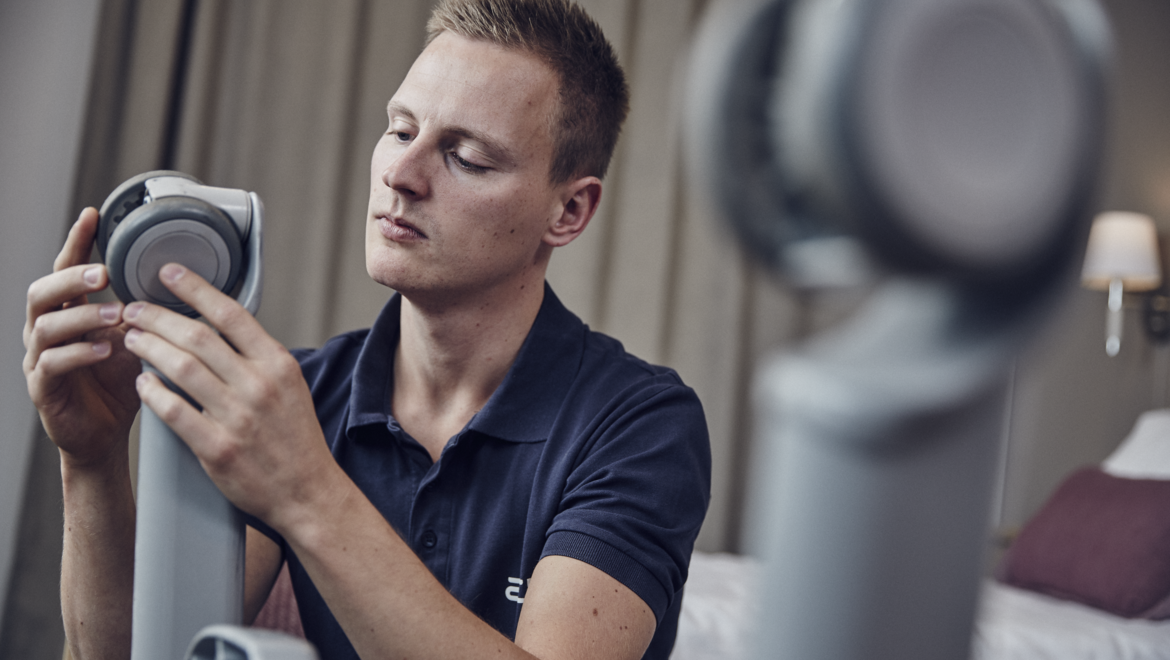Arjo Care Covid-19 Report: USA
Our final Covid-19 report comes from the USA, where Ismael Duenes, Vice President US Service, describes the "daily heroics" of his team to go above and beyond for our customers, even in the toughest of times.
“We were working every day to keep our employees safe.”
In 2018, Arjo USA began the process of combining their service and rental teams, bringing together resources and assets, with the aim to streamline operations as well as improve overall customer experience.
“Combining the service team positioned us to better manage significant swings in demand by enabling our front line managers to pivot manpower where and when needed,” explained Ismael Duenes, who leads a capital and rental service team of 425 staff across the United States.
“As you can imagine, there was a lot of adjustment that had to take place. We had to take the time to communicate the plan to the entire team and make sure everyone understood what was happening and why the change was necessary.
“By 2019 we were well on our way to fully executing the plan. We had completed the restructuring, and had begun driving performance improvement.”
Then in April 2020, lockdown directives began rolling across the United States as local COVID case numbers grew, putting the new team structure to its first significant test. Whilst from an operational standpoint the team did their best to adjust, they suddenly had to keep up with growing demand along with other challenges, such as figuring out a safety protocol and shifting the communication approach from in-person to virtual.
“Prior to the pandemic, we would have in person quarterly business reviews with managers to engage them in the development of the team and really drive the business. When the pandemic hit, this went from a really forward, proactive approach to a more reactive approach simply because we are all trying to understand the impact COVID would have on the market,” said Ismael.
“We were working every day to figure out how to keep our employees safe, what the new rules were in terms of accessibility and quickly learned that the traditional ways we’ve been accustomed to doing business were, in some cases, no longer viable.
“We were also still getting used to doing things virtually. At first we were using Skype, then we were getting into Zoom and finally Teams which is the tool we use today.
“All this really made us rethink many of the things we did and how we did them. I was a little naïve at the time, thinking we would go back to some kind of normal in three to six months, but soon realised that wasn’t going to be the case.”
“We made sure we were always a hundred percent aligned.”
The resulting healthcare crisis swiftly drove up demand for care equipment. Normally a welcome business opportunity, the uptick was so sharp that it presented massive supply, manpower and logistical challenges.
“Demand skyrocketed almost overnight. There were several months where demand tripled compared to pre-pandemic levels. Our team experienced situations in many service centres where we had no products to rent because it had all had been rented,” Ismael recalled.
Ismael, David Freeman (director of inventory) and Dan Raffensberger (managing director, sales) began meeting daily on key business decisions related to inventory levels and movements to ensure the combined teams were aligned on the right priorities.
“Prior to the pandemic, our field managers were somewhat autonomous, and made decisions about local inventory and other aspects of the business – they had to, in order for us to be efficient,” he explained. “But because of the sudden rise in demand, it became apparent to us that if we didn’t control inventory very closely and at a national level we would find it very difficult to meet customer demands. So we decided to centralise inventory management decisions on a temporary basis – all inventory movement decisions were made at a national level for all service centers across the US.
“The collaborative effort between Supply Chain, Sales and Service was what really prevented us from getting in a difficult situation with our long-term customers. We made sure we were always a hundred percent aligned on what our priorities were and where we were focusing our efforts. We tried to make the best decisions to meet customer demands as efficiently as we could.”
“Never once did someone on our team say we can’t, or we won’t.”
With orders coming in at unprecedented numbers and incredibly stressed-out customers racing against time to save lives, Ismael credits the combined team for stepping up with “everyday heroism” and going the extra mile to help as many customers as possible.
“Our team performed admirably. If there was an opportunity to get a patient a bed, they would do their absolute best to do so,” he recalled.
“They were doing halfway-meets and long-distance deliveries. There were capital technicians working on rental equipment. If there was a bed that needed to be cleaned, someone cleaned it, if there was an assist that needed to happen for a delivery, someone stepped up, regardless of their actual job descriptions and responsibilities.
On the capital service side of the business our technicians found creative ways to support customers while abiding by lockdown rules and minimising infection risk, and the team quickly started sharing ideas and putting them in motion.
“I think this was a really a big highlight for us. Because we brought the organisations together, the teams were already interacting. A lot of creative things started happening. They would offer to work on customer equipment in their parking lot. They set up large canopies to work outdoors, they coordinated pick-up and drop-off points with the rental team to pick up equipment and take them back to the service centre, where the technicians could service them,” recalled Ismael.
“In places where we had really good relationships with the customers and knew that they had an onsite technician, we would guide them through repairs and over a video call or FaceTime.
“We used our virtual townhall meetings to share more ideas. Our teams exchange and verbalise new ways to provide service to our customers. People got really creative, it was really great to see.”
“It wasn’t just the frontline team. It was the back office, the order-entry team, the safety and compliance team, the management, all doing what was needed to make sure we could keep that product flowing to our customers.”

The rental service team in Roselle, Chicago, part of 425 full-time staff including 380 frontline staff who comprise the Arjo USA capital and rental service team.
“Above all else, the team prioritised the customers.”
On top of the myriad work challenges, there was no relief from the impact of Covid-19 at the end of the work day.
“I am sure the situation took a toll on the team. Our rental team worked very long hours, in an environment with high risks, and even our back office team who are used to a very structured work environment suddenly had to deal with a lot of change like working from home. You could see and feel fluctuations in the morale,” explained Ismael.
“Some places remained on lockdown for extended periods so colleagues who were based there couldn’t even do normal activities with their family, which certainly added to the stress levels. But the team has shown such resilience. They bounced back, and as an organisation we worked to address concerns and get ahead of issues as quickly as possible.
“One of the most challenging situations our team dealt with was having to manage service centre closures due to a positive COVID test.”
Every positive test meant contact tracing, shutting down an affected site, and sending all staff based at that site to get tested and stay home until the site was fully disinfected. After that, employees who tested negative could return to work.
“Overall our team has been very helpful and proactive when these situations occurred because they understood it was in the best interest of the collective team,” said Ismael. “Through it all the team showed nothing but support for each other, as well as strong commitment to their work.
“Above all else, I think the team absolutely prioritised the customers. Top down, bottom up, everybody understood what we needed to do, and did it day in and day out. I can’t remember an instance where there was an issue or question about our goals or priorities.
“Led by our President, Anne (Sigouin) there was a lot of personal engagement, there were a lot of positive messages – emails, texts, calls – Anne recognised that our service organisation was under tremendous pressure for most of the year – long hours, huge demands. So she did everything she could to make sure the team felt supported and was recognised for their efforts.
“That’s reflective of the entire leadership team in the US: Giving people a pat on the back, providing support, or lending a helping hand when needed.”
“It’s like you’re seeing everybody for the first time.”
16 months since lockdowns began, the pandemic still stretches on, but Ismael is hopeful that normalcy is on the horizon.
“When the lockdown began, the government put out some criteria for identifying essential workers. Our staff meet these criteria, so we developed the documentation for them to be identified as essential workers,” said Ismael.
“This enabled them to continue working, or travel regionally to deliver crucial equipment. Then when vaccinations became available, our frontline staff were prioritised because essential workers are prioritised. However, they’re distributed in different ways depending on the local government’s approach.”
Nevertheless, with many choosing to be vaccinated and local restrictions being lifted, even back office staff are once again reporting to the office for work, and regional work travel is once again possible.
“What I miss most about the pre-pandemic time is interacting directly with our colleagues,” said Ismael. “We’re starting to open some offices again, and it’s like you’re seeing everybody for the first time. I was in Addison recently, and some of our finance, marketing and sales teams were back in the office. I haven’t seen many of them in a long time so there was genuine excitement and happiness to see people in person again.
“Working in an environment with people whom you enjoy working with, those are things that keep you going and make the job more fulfilling. This was something I’ve definitely missed.”
Find out more about Arjo Care here or read more Covid-19 stories from Canada, Spain, and the Netherlands on the Arjo Blog.





